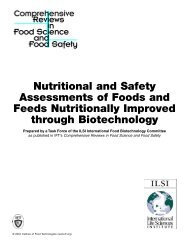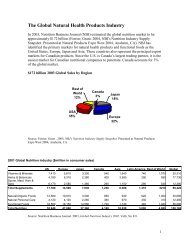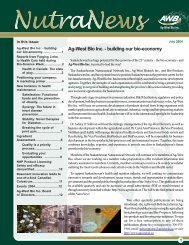Beyond Borders: Global biotechnology report 2010
Beyond Borders: Global biotechnology report 2010
Beyond Borders: Global biotechnology report 2010
You also want an ePaper? Increase the reach of your titles
YUMPU automatically turns print PDFs into web optimized ePapers that Google loves.
developed countries — and whether that<br />
recovery takes the shape of a “U” (slow) or<br />
a “W” (a double-dip downturn). Thus biotech<br />
companies — particularly the vast majority<br />
that are unable to finance on the heels of<br />
breakthrough clinical news — will have to<br />
navigate an uncertain and likely volatile<br />
fund-raising environment for the foreseeable<br />
future. Given the substantially slower pace of<br />
fund flows into the venture capital industry,<br />
A closer look<br />
the biotech industry will not see a quick<br />
return to the venture funding levels of 2007<br />
and 2008. Venture capitalists, whether<br />
surviving or thriving, will continue to raise<br />
the bar on the companies they back and will<br />
explore alternative models to deploy capital<br />
more efficiently.<br />
Still, corporate venture capital — whether<br />
direct or funneled through established<br />
Tapping economic development incentives<br />
As funding options have dwindled in the current financing<br />
environment, companies need to be increasingly creative in<br />
finding new sources of capital. It is not surprising that state and<br />
local economic development incentives are getting increased<br />
attention, since such incentives can help improve cash flow, pay<br />
for capital acquisitions and job creation, and provide financing at<br />
below-market rates.<br />
But the labyrinth of state and local economic development<br />
agencies is unfamiliar territory for many biotech companies,<br />
which have traditionally focused on conducting R&D and<br />
raising money from VCs and the capital markets. To secure<br />
a comprehensive incentives package, companies often<br />
need to meet with multiple state and local agencies several<br />
times, complete lengthy applications and collect extensive<br />
documentation — all while trying to keep their projects on track<br />
and on time.<br />
To succeed, companies need a strategic approach that<br />
incorporates three critical elements:<br />
Effective data collection. Many incentives programs require a<br />
company to commit to certain levels of capital investment and/<br />
or job growth or retention. Consequently, it is critical to have<br />
ready access to meaningful data that can inform incentivesrelated<br />
decisions. This includes projected capital investment<br />
data (both routine and extraordinary spending) as well as data<br />
on projected human resources needs (job creation, layoffs,<br />
consolidations, training and employee-development needs).<br />
A single uniform process. The process of obtaining economic<br />
incentives is an ongoing one that requires monitoring over<br />
74 <strong>Beyond</strong> borders <strong>Global</strong> <strong>biotechnology</strong> <strong>report</strong> <strong>2010</strong><br />
VC firms — is almost certainly going to<br />
increase, as pipeline-starved pharma<br />
companies have a vested interest in<br />
fostering a drug discovery ecosystem that<br />
includes a healthy number of innovative<br />
and focused biotech companies. Expect<br />
to see new investment and collaboration<br />
structures that include increased<br />
optionality for investors and companies.<br />
Ron Xavier<br />
Ernst & Young LLP<br />
time. The process begins with reviewing the capital and human<br />
resource investment data to identify and qualify potential<br />
opportunities. Once a company identifies the incentives<br />
programs that are most relevant, the next step is to pursue<br />
these opportunities with the relevant governmental authorities.<br />
Finally, once these incentives are secured, the company will<br />
establish protocols to meet compliance requirements on an<br />
ongoing basis.<br />
Stakeholders. The incentives process can affect many different<br />
functions within a company, including real estate, operations,<br />
human resources, tax, finance and government affairs. A<br />
single group or business division is unlikely to have adequate<br />
information or resources to effectively pursue and secure<br />
a comprehensive incentives package. The most successful<br />
incentives plans therefore involve a coordinated effort across<br />
departmental lines. Input from all affected groups will ensure<br />
the company takes a holistic approach to securing incentives<br />
that best meets the company’s total needs.<br />
We are already seeing increased biotech company interest in<br />
economic development incentives. In the “new normal,” the<br />
trend is likely to continue. Despite their budgetary pressures,<br />
state and local governments regard biotech companies as<br />
desirable targets and drivers of long-term economic development<br />
and job creation. With the right focus and a strategic approach,<br />
there is no reason why more biotech companies should not be<br />
able to avail themselves of these funds.








